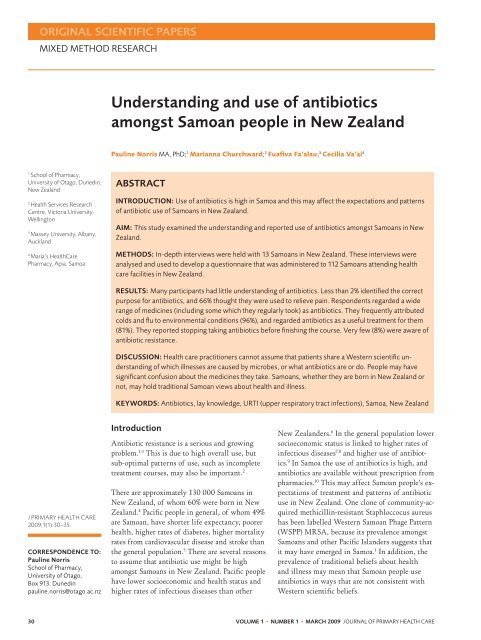entire issue. - The Royal New Zealand College of General ...
entire issue. - The Royal New Zealand College of General ...
entire issue. - The Royal New Zealand College of General ...
Create successful ePaper yourself
Turn your PDF publications into a flip-book with our unique Google optimized e-Paper software.
ORIGINAL SCIENTIFIC PAPERS<br />
MIXED METHOD RESEARCH<br />
1 School <strong>of</strong> Pharmacy,<br />
University <strong>of</strong> Otago, Dunedin,<br />
<strong>New</strong> <strong>Zealand</strong><br />
2 Health Services Research<br />
Centre, Victoria University,<br />
Wellington<br />
3 Massey University, Albany,<br />
Auckland<br />
4 Maria’s HealthCare<br />
Pharmacy, Apia, Samoa<br />
J PRIMARY HEALTH CARE<br />
2009;1(1):30–35.<br />
CORRESPONDENCE TO:<br />
Pauline Norris<br />
School <strong>of</strong> Pharmacy,<br />
University <strong>of</strong> Otago,<br />
Box 913, Dunedin<br />
pauline.norris@otago.ac.nz<br />
Understanding and use <strong>of</strong> antibiotics<br />
amongst Samoan people in <strong>New</strong> <strong>Zealand</strong><br />
Pauline Norris MA, PhD; 1 Marianna Churchward; 2 Fuafiva Fa’alau; 3 Cecilia Va’ai 4<br />
ABSTRACT<br />
INTRODUCTION: Use <strong>of</strong> antibiotics is high in Samoa and this may affect the expectations and patterns<br />
<strong>of</strong> antibiotic use <strong>of</strong> Samoans in <strong>New</strong> <strong>Zealand</strong>.<br />
AIM: This study examined the understanding and reported use <strong>of</strong> antibiotics amongst Samoans in <strong>New</strong><br />
<strong>Zealand</strong>.<br />
METHODS: In-depth interviews were held with 13 Samoans in <strong>New</strong> <strong>Zealand</strong>. <strong>The</strong>se interviews were<br />
analysed and used to develop a questionnaire that was administered to 112 Samoans attending health<br />
care facilities in <strong>New</strong> <strong>Zealand</strong>.<br />
RESULTS: Many participants had little understanding <strong>of</strong> antibiotics. Less than 2% identified the correct<br />
purpose for antibiotics, and 66% thought they were used to relieve pain. Respondents regarded a wide<br />
range <strong>of</strong> medicines (including some which they regularly took) as antibiotics. <strong>The</strong>y frequently attributed<br />
colds and flu to environmental conditions (96%), and regarded antibiotics as a useful treatment for them<br />
(81%). <strong>The</strong>y reported stopping taking antibiotics before finishing the course. Very few (8%) were aware <strong>of</strong><br />
antibiotic resistance.<br />
DISCUSSION: Health care practitioners cannot assume that patients share a Western scientific understanding<br />
<strong>of</strong> which illnesses are caused by microbes, or what antibiotics are or do. People may have<br />
significant confusion about the medicines they take. Samoans, whether they are born in <strong>New</strong> <strong>Zealand</strong> or<br />
not, may hold traditional Samoan views about health and illness.<br />
KEyWORDS: Antibiotics, lay knowledge, URTI (upper respiratory tract infections), Samoa, <strong>New</strong> <strong>Zealand</strong><br />
Introduction<br />
Antibiotic resistance is a serious and growing<br />
problem. 1-3 This is due to high overall use, but<br />
sub-optimal patterns <strong>of</strong> use, such as incomplete<br />
treatment courses, may also be important. 2<br />
<strong>The</strong>re are approximately 130 000 Samoans in<br />
<strong>New</strong> <strong>Zealand</strong>, <strong>of</strong> whom 60% were born in <strong>New</strong><br />
<strong>Zealand</strong>. 4 Pacific people in general, <strong>of</strong> whom 49%<br />
are Samoan, have shorter life expectancy, poorer<br />
health, higher rates <strong>of</strong> diabetes, higher mortality<br />
rates from cardiovascular disease and stroke than<br />
the general population. 5 <strong>The</strong>re are several reasons<br />
to assume that antibiotic use might be high<br />
amongst Samoans in <strong>New</strong> <strong>Zealand</strong>. Pacific people<br />
have lower socioeconomic and health status and<br />
higher rates <strong>of</strong> infectious diseases than other<br />
<strong>New</strong> <strong>Zealand</strong>ers. 6 In the general population lower<br />
socioeconomic status is linked to higher rates <strong>of</strong><br />
infectious diseases 7,8 and higher use <strong>of</strong> antibiotics.<br />
9 In Samoa the use <strong>of</strong> antibiotics is high, and<br />
antibiotics are available without prescription from<br />
pharmacies. 10 This may affect Samoan people’s expectations<br />
<strong>of</strong> treatment and patterns <strong>of</strong> antibiotic<br />
use in <strong>New</strong> <strong>Zealand</strong>. One clone <strong>of</strong> community-acquired<br />
methicillin-resistant Staphloccocus aureus<br />
has been labelled Western Samoan Phage Pattern<br />
(WSPP) MRSA, because its prevalence amongst<br />
Samoans and other Pacific Islanders suggests that<br />
it may have emerged in Samoa. 1 In addition, the<br />
prevalence <strong>of</strong> traditional beliefs about health<br />
and illness may mean that Samoan people use<br />
antibiotics in ways that are not consistent with<br />
Western scientific beliefs.<br />
30 VOLUME 1 • NUMBER 1 • MARCH 2009 J OURNAL OF PRIMARY HEALTH CARE

















